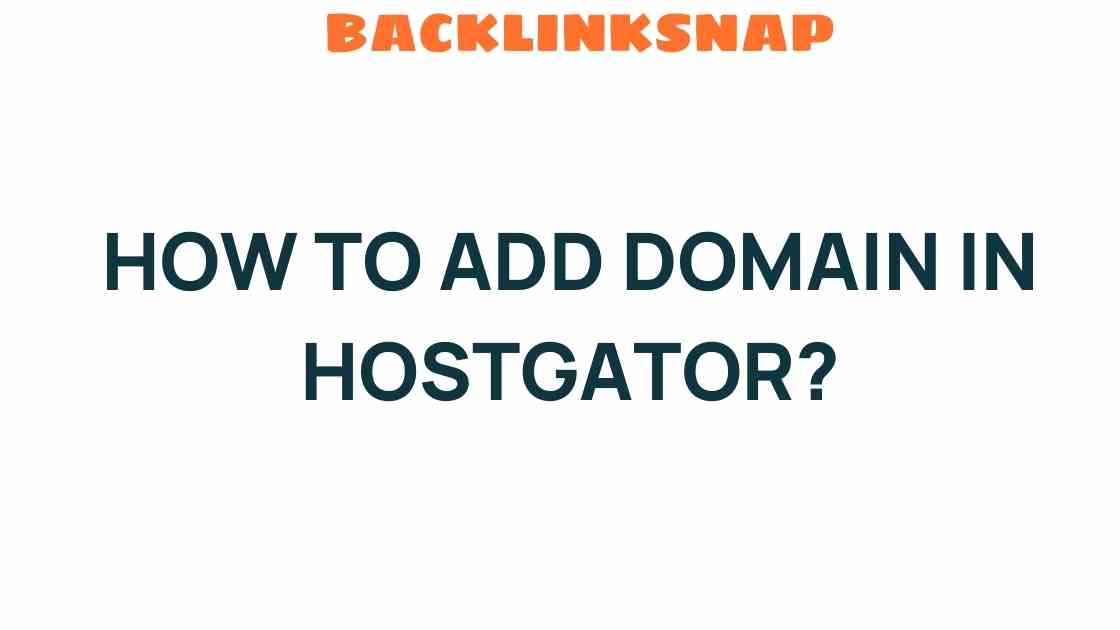Unlocking the Secrets: How to Add Domain in HostGator Effortlessly
In the world of web hosting, HostGator stands out as a leading provider, known for its reliability and user-friendly services. Many individuals and businesses are eager to establish an online presence, and one of the crucial steps in this journey is to effectively add a domain to your hosting account. This article aims to guide you through the process of domain management and configuration within HostGator’s interface, specifically using cPanel, ensuring a smooth website setup.
Understanding HostGator and Its Services
HostGator is a well-respected web hosting company that offers a variety of services tailored for beginners and seasoned web developers alike. From shared hosting to dedicated servers, HostGator provides a flexible range of options that cater to the diverse needs of its clientele. Its user-friendly interface and excellent customer support make it an appealing choice for anyone looking to enhance their online presence.
Why You Should Add a Domain
Adding a domain to your HostGator account is essential for several reasons:
- Brand Identity: A domain name strengthens your brand’s identity, making it easier for customers to find you online.
- Professionalism: A custom domain boosts your credibility, setting you apart from competitors.
- SEO Benefits: Proper domain management can significantly enhance your search engine optimization efforts.
- Control: Managing your domain directly gives you greater flexibility in configuring your website’s settings.
Getting Started: Accessing Your HostGator cPanel
Before diving into the details of how to add a domain, you first need to access your HostGator cPanel. Here’s how:
- Log in to your HostGator account. You’ll be greeted with the dashboard.
- Locate the “cPanel” button in your dashboard and click on it.
Once you’re in cPanel, you’ll find an array of options at your disposal. This interface is where the magic happens when it comes to domain management.
How to Add a Domain in HostGator
Now, let’s walk through the steps to add a domain in HostGator. Follow these simple instructions:
In the cPanel, scroll down to find the “Domains” section. Within this section, you will see several options, including “Addon Domains,” “Subdomains,” and “Aliases.”
2. Click on Addon Domains
Select the “Addon Domains” option. This feature allows you to host additional domains on your existing account.
3. Fill Out the Domain Information
Here’s where you’ll enter the relevant information for the new domain:
- New Domain Name: Enter the domain name you wish to add (e.g., example.com).
- Subdomain: This will automatically populate based on your domain name.
- Document Root: This is the directory where the files for your new domain will be stored. You can leave it as default, or customize it if you prefer.
- Password: Create a password for the FTP account associated with this domain.
4. Click on Add Domain
Once you’ve filled in all the necessary information, click the “Add Domain” button. Within moments, HostGator will process your request, and you’ll see a confirmation message indicating that your domain has been successfully added.
Configuring Your New Domain
After adding your domain, it’s time to configure it. Here’s how to get started:
- DNS Settings: Ensure that your domain’s DNS settings are pointing to HostGator’s nameservers. This step is crucial for your domain to resolve correctly.
- Email Accounts: Create email accounts associated with your new domain through the “Email Accounts” section in cPanel.
- Website Files: Upload your website files to the document root directory you specified earlier. You can use the File Manager in cPanel or an FTP client.
Common Issues and Troubleshooting
While adding a domain in HostGator is generally straightforward, you might encounter some common issues:
- DNS Propagation: Changes to DNS settings can take up to 48 hours to propagate fully.
- Existing Domain Ownership: Ensure that the domain you’re trying to add isn’t already registered elsewhere unless you’re transferring it.
- Incorrect Nameservers: Double-check that your domain is pointing to the correct HostGator nameservers.
FAQs About Adding Domains in HostGator
1. Can I add multiple domains to my HostGator account?
Yes, you can add multiple domains by using the Addon Domain feature in your cPanel. However, the number of domains you can add depends on your hosting plan.
2. How long does it take for my new domain to be active?
Once added, it can take anywhere from a few minutes to 48 hours for your domain to become active, depending on DNS propagation.
3. Do I need to purchase a domain through HostGator?
No, you can purchase your domain from any registrar and still add it to your HostGator account.
4. Can I transfer my existing domain to HostGator?
Yes, you can transfer your domain to HostGator, but you’ll need to follow specific steps provided by them.
5. What if I encounter issues while adding a domain?
If you run into problems, HostGator’s customer support is available 24/7 to assist you.
6. Are there any additional costs for adding a domain?
Adding an addon domain typically does not incur additional charges, but ensure you check your hosting plan details.
Conclusion
Adding a domain in HostGator is a pivotal step in establishing your online presence and enhancing your brand. By following the steps outlined above, you can effortlessly manage your domain configurations through an intuitive interface like cPanel. Empowering yourself with this knowledge not only simplifies your web development journey but also enables you to focus on creating engaging content for your audience. Remember, whether you’re a beginner or an experienced developer, HostGator’s support and resources are always at your disposal, ensuring your path to success is smooth and enjoyable.
For more detailed insights on web hosting, check out HostGator’s official site. For additional resources on web development, visit W3Schools.
This article is in the category Digital Marketing and created by BacklinkSnap Team




